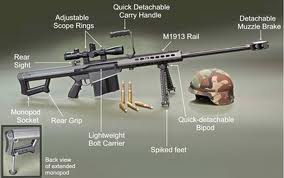 A bullet hole left in one helicopter's plate glass window is one exhibit in an exhaustive House Committee on Oversight and Government Reform report released Tuesday showing the breadth of a high-stakes, unprecedented, and, ultimately, ill-advised US scheme called "Operation Fast and Furious."
A bullet hole left in one helicopter's plate glass window is one exhibit in an exhaustive House Committee on Oversight and Government Reform report released Tuesday showing the breadth of a high-stakes, unprecedented, and, ultimately, ill-advised US scheme called "Operation Fast and Furious."
The .50 caliber bullet hole, the report says, likely came from a gun trafficked via Fast and Furious, an operation to allow nearly 2,000 arms to leave US gunshops via certain traffickers who the US government had identified and thought it could track. The idea was to trace these "straw buyers" to key cartel figures in an attempt to score major gun busts to prove the US was serious about stopping arms trafficking across the border.
Instead, the report alleges that the operation – which one US official has called "a perfect storm of idiocy" – likely allowed hundreds of powerful guns to cross into Mexico, possibly changing the outcome of cartel battles with Mexican police, leading to the deaths of many Mexicans and one federal agent, Border Patrol Agent Brian Terry, and damaging diplomatic relations between the US and Mexico.
The Fast and Furious scandal is still playing out, with hearings in the House Oversight Committee Tuesday. Chairman Rep. Darrell Issa (R) of California says he is intent on finding out how high in the Obama administration knowledge of the operation went.
The report, "Fueling Cartel Violence," backs reports that leaders in the federal Bureau of Alcohol, Tobacco, Firearms, and Explosives (ATF) were aware of the operation. But it also names several key Department of Justice officials, such as Assistant Attorney General Lanny Breuer, as "clearly" being aware of the operation – a charge that the Obama administration denies.
According to whistleblowers and key witnesses, however, the real lesson behind Fast and Furious, a two-year operation that ended in January 2011, is how "groupthink" clouded decision-making at the highest levels of government, causing an agency to go against its basic instincts – which is to not allow arms to be trafficked illegally – and consequently contribute, not detract, from border violence.
"These guns weren't going for a positive cause, they were going for a negative cause," ATF attaché Carlos Canino told the congressional oversight committee. "The ATF armed the [Sinaloa] cartel. It's disgusting."
Despite repeated pushback from some agents and the attaché office in Mexico City, ATF Acting Director Kenneth Melson assessed it as "a good operation," the report says. According to witnesses, Assistant Attorney General Breuer appeared to cite Fast and Furious in meetings with Mexican officials, saying the US had a major gun-interdiction effort underway out of Phoenix, the report adds.
Where the guns went
The plan was to trace the guns through straw buyers to major cartels, to then build cases and make arrests. But early on, it became evident that tracking the guns had become a problem and that hundreds had made their way across the border and disappeared into cartel gun caches. According to the report, Fast and Furious guns made their way to three prominent Mexican cartels: Sinaloa, El Teo and La Familia.
The Spanish Untouchables
-
[image: Busto del Rey Juan Carlos I de España en su vi...]
A new tell-all book that details what led to Spanish king Juan Carlos
giving up the throne wou...


















0 comments:
Post a Comment